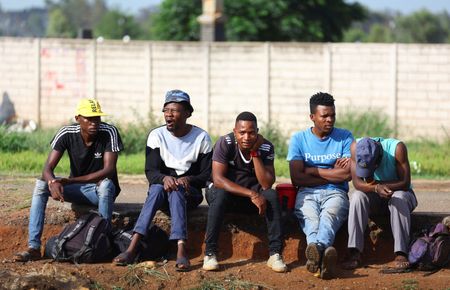By Maytaal Angel and Maxwell Akalaare Adombila
LONDON/ACCRA (Reuters) – Trading houses face losses of at least $1 billion on cocoa derivatives after major producer Ghana failed to deliver beans this year, forcing traders to liquidate short positions in a rallying market, six industry sources told Reuters.
Global cocoa prices soared this year after bad weather, bean disease, smuggling and illegal gold mining reduced production and the volume of beans available in Ghana, the world’s No.2 producer.
Chocolate prices also rose globally and chocolate makers have reduced the size of products such as bars as a result of the huge cocoa price increase.
Ghanaian authorities, who sell all of the country’s beans, want to delay delivery of up to 350,000 metric tons this season – nearly half of the cocoa beans they sold – due to Ghana’s devastated crop, five sources told Reuters last month. Ghana’s cocoa regulator said the country was looking to roll over “some volumes, but not in those quantities”.
A delay of 350,000 tons means cocoa traders and processors could face losses of about $4,000 per ton on cocoa futures they had bought to hedge their physical bean purchases, or around $1.4 billion combined, the sources said.
Trade houses like Cargill, Olam and Barry Callebaut use the futures market to hedge or lock in a price for cocoa they have not yet sold on to chocolate makers.
“We’re sitting staring at our screens, barely trading,” said the head cocoa trader at a global trading house specialising in agricultural commodities, speaking on condition of anonymity because he was not authorised to talk to the media.
He said trading in the global cocoa physical and futures market has just about ground to a halt as a result of the deep losses and uncertainty.
Much of Ghana’s cocoa is bought by large, diversified trade houses with deep pockets, including Sucden, Olam, Barry Callebaut, Cargill, Touton and Ecom.
Traders typically sign deals to buy beans – like any other commodity – months in advance in the hope of reselling later at a profit. By doing so they take a so called long position in the physical market.
As they wait for the physical commodity to be delivered for weeks or months they need to protect themselves against possible price falls. They typically do this by taking short positions in the futures market to protect against losses on a long position.
Short trading bets on price falls so when the physical commodity arrives, long and short positions cancel each other out, guaranteeing a fixed price.
The strategy unravels, however, if physical delivery – in this case cocoa beans – is delayed in a rallying market.
If this happens, traders are forced to liquidate short positions for the month they had expected the commodity to arrive and take a new short position for the month of a new expected delivery.
Doing so in April 2024 – after the market realised Ghana would delay bean delivery to 2025 – would have been costly, according to the traders.
The six sources said last year traders who bought physical beans for May 2024 delivery would have taken equivalent short positions in May 2024 futures at around $3,000 a ton.
With the market rallying in April 2024, those traders had to liquidate May 2024 shorts – or buy the futures back – at $11,000 a ton, facing losses of $8,000 a ton.
As traders still hope to get the cocoa and need to protect themselves in the physical market, they had to take on new short positions for May 2025 delivery, which in April 2024 traded around $7,000 a ton.
That means that if and when traders get their physical cocoa next May at $3,000 a ton, they will still face an aggregate loss of $4,000 per ton.
The cocoa market is facing a third successive year of deficit and prices have roughly doubled this year.
Traders will try to recoup at least some of their losses by charging chocolate makers like Hershey and Mondelez higher prices for products like cocoa powder and butter, said a top trader at a global agri-commodity trade house.
Chocolate firms will likely struggle to pass on these costs to cash-strapped consumers who are already buying less chocolate in response to price rises.
Market liquidity has also decreased because of exchanges asking traders to post more cash as collateral to cover their hedges, one of the traders said. This liquidity crunch has fuelled price fluctuations or volatility, he added.
The collateral, known as a margin call, is set by the futures exchange as a down payment that covers a portion of the potential losses traders might face on their futures position. The higher the futures price, the higher the margin calls.
(Reporting by Maytaal Angel in London, Maxwell Akalaari Adombile in Accra, and Ange Aboa in Abidjan; Editing by Dmitry Zhdannikov and Emelia Sithole-Matarise)











